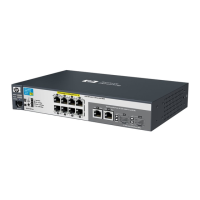1-10
IPv6 Addressing Configuration
Configuring a Static IPv6 Address on a VLAN
Statically Configuring A Global Unicast Address
■ If IPv6 was enabled only by a statically configured link-
local address, then deleting the link-local address disables
IPv6 on the VLAN.
■ If other IPv6-enabling commands have been configured on
the VLAN, then deleting the statically configured link-local
address causes the switch to replace it with the default
(EUI-64) link-local address for the VLAN, and IPv6
remains enabled. (For more on the EUI-64 address format,
refer to “Disabling IPv6 on a VLAN” on page 1-12.)
Refer also to “Disabling IPv6 on a VLAN” on page 1-12.
Syntax:.
[no] ipv6 address < network-prefix><device-id >/< prefix-length >
[no] ipv6 address < network-prefix>::/< prefix-length > eui-64
If IPv6 is not already enabled on a VLAN, either of these
command options do the following:
■ enable IPv6 on the VLAN
■ configure a link-local address using the EUI-64 format
■ statically configure a global unicast address
If IPv6 is already enabled on the VLAN, then the above
commands statically configure a global unicast address, but
have no effect on the current link-local address.
< network-prefix >: This includes the global routing prefix and
the subnet ID for the address. For more on this topic, refer to
“Router Access and Default Router Selection” on page 1-23.
< device-id >: Enters a user-defined device identity.

